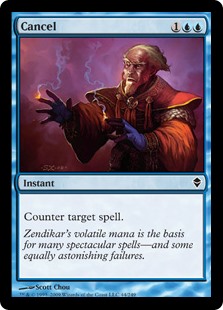Negation, one of the most common elements of any card game. It prevents an opponent from putting something into play and quickly dismisses it, leaving you to see another turn if you negated the right thing. However, negation does have it's issues.
But how can negation be so complicated, you ask?
Simple. It's all in the wording and the purpose.
First off, when you negate an opponent's card, it's quickly sent to the discard pile or graveyard as a result. Thus, said card never actually got to see play. But again, it's not as simple.
Why? Here's an example as to how negation can complicate things.
To use Solemn Warning as an example, it states that it negates AND destroys said card. Normally, this would never be an issue. However, there are cards that have either vague rulings or effects that they can simply activate even when they are negated. A prime example of this can be found in either Light and Darkness Dragon or Scrap Dragon, which state that their effects activate when they are destroyed and sent to the graveyard. However, the wording doesn't state from where it has to be destroyed (such as Dandylion activating when sent to the graveyard from anywhere, even as an Xyz Material).
 |
| "When this card is destroyed by your opponent's card (either by battle or card effect) and sent to the graveyard..." |
Such wording creates a loophole in which the player can simply activate their effects upon their destruction, even after being negated. Why is that? "Negate AND destroy that card" can be blamed for such things. Now while this seems like a perfectly normal thing, considering how YGO has always said negate and destroy, it creates a different meaning as to what negation means all together. It should be about stopping a play completely, not having said negation backfire by a loophole.
Now, let's look at a prime example of what negation looks like in another game, shall we?
 |
| "To counter a spell or ability is to remove it from the stack, usually placing it in its owner's graveyard. This prevents the spell or ability from resolving." |
This example from MTG is rather simple. Negate a spell, period. Now when you look at the rulebook it states that it doesn't hit the field and doesn't resolve. This is quite contrary in YGO, as it applies probably 98% of the time due to the negate and destroy wording that allows certain cards to resolve due to their destruction.
But negation isn't just limited to preventing your opponent from putting things in play, it's also a means of defense. For example, there are cards that can prevent attacks or abilities. In cases like these, they don't necessarily have to be put into the graveyard. Prime examples of these can be Skill Drain for YGO, since it only negates monster effects but doesn't necessarily remove any cards from active play.
 |
| A prime example of negation without removal. |
So now we saw how negation can vary in styles. There's the negation that prevents cards from being played (such as Solemn Judgment or Cancel), and then we have the kind of negation that doesn't remove cards from active play (Negate Attack or Fog) as a means of preventing effects or damage. So next time you are out to consider negating some of your opponent's plays, consider how it will negate so you can fully understand any of the following backlash. Whether it's a purposeful summon of Scrap Dragon to bait negating to trigger it's effect or the forceful negation of a card to drain your opponent's mana resources, negation has it's pros and cons. While a defensive move, it can all backfire depending on the wording of said negation.








